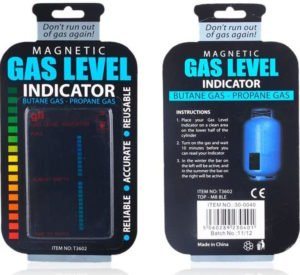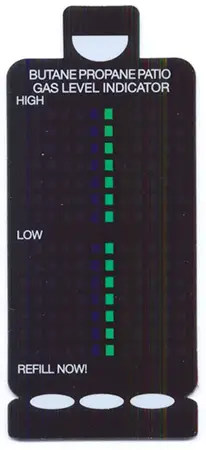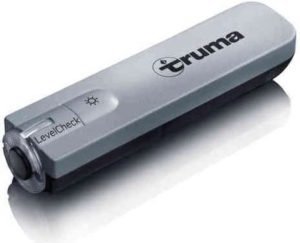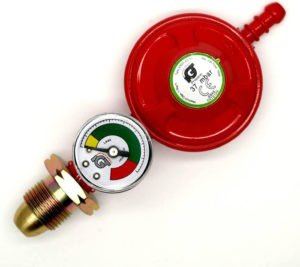If you’re a veteran caravan owner, then you’ve probably said goodbye to only cooking with microwaves.
By now you’ve stepped up to gas-powered stoves for a better cooking experience, allowing you to eat a wider range of foods.
However, this comes with the potential situation where you run out of gas. Which nearly always happens when you’re in the middle of something important – like cooking a meal.
A gas bottle level indicator gives you a clear idea of how much gas is left in the tank, making them one of the more useful tools to have in your caravan.
In our guide below, we show you 3 of the best gas bottle level indicators. Invest in one and you’re unlikely to run out of gas anytime soon!
4 Best Gas Bottle Level Indicators
Sound Vision Magnetic Gas Level Indicator

Many of the new gas indicator brands use magnetic technology to measure the current levels; however, not all of these tools are effective, so you need to search to find one that works. The Sound Vision magnetic gas level indicator delivers on its promises and is highly-rated.
All you need to do is place the indicator on the lower half of your gas cylinder and then switch on the gas supply. After around 10 minutes, the indicator bar will light up and give you a reading depending on the time of year.
In the winter the bar on the left-hand side will be used whereas in the summer there will be a bar on the right that will populate.
Because it’s magnetic, it means that you can move it from cylinder to cylinder for multiple uses.
But – and this is important to remember – you have to wait the full 10 minutes to get the reading. It doesn’t happen straight away, which may cause confusion with those who haven’t read the instructions beforehand…
Magnetic Gas Bottle Gas Level Indicator

Here’s another gas bottle level indicator using magnetic technology to supply a reading.
It’s about as thick as a credit card (114 x 50mm), and is simple to install. Just attach it to the bottom half of your gas cylinder and switch on the gas. The liquid crystals change colour to indicate how much gas is remaining, making for a handy little traffic light system.
The indicator is suitable for propane, butane or mixed fuel gas cylinders.
Our only complaint is that the indicator is flat, and gas bottles are… round. Meaning, it doesn’t stick on particularly efficiently. But it does still stick.
If your gas bottle has ridges, however, the flat shape of this tool can cause problems.
Be sure to read the instructions fully beforehand for the most accurate setup and readings.
Truma LevelCheck Gas Indicator

Many different gas indicator brands are appearing, but the Trauma LevelCheck gas indicator is one of the clear leaders, and this has resulted in them winning many industry awards for the effectiveness of the product.
The indicator is designed to be compatible with all-steel LPG and aluminium cylinders which will cover most caravan owners. The diameter of the cylinders needs to be between 200 and 250mm for the reading to be accurate.
To use, you simply attach the indicator in a horizontal position to your cylinder, and it has built-in ultrasound technology which then discovers how full your cylinder is. It has a LED display which will turn green if you have gas left in the cylinder or red if you have no gas. This LED screen will automatically turn off once you have finished measuring.
This is a simple product, but it does the job well while also having a long-lasting, sturdy construction. It also has a built-in flashlight.
Unfortunately, it’s hard to find in stock!
Igt 37Mbar Propane Gas Regulator

Okay, so this is primarily a Propane gas regulator, but you can use it to discover whether your gas tank has gas or not. The regulator is compatible with any brand of screw-in type red Propane cylinders, and it has an inbuilt pressure gauge.
It will tell you the current pressure in the cylinder and will give a few hours pre-warning before completely running out. This is because the pressure will drop – however it won’t tell you the exact amount of gas that’s left in the cylinder.
What you will get is a high-quality product that’s built to last and functions exactly as described and will be a great addition to your gas cylinder.
It’s not the perfect solution in that it doesn’t indicate how much gas you have left, but it will give you a timely warning when you’re running low. Hopefully before you’re preparing dinner!
What Is a Gas Bottle Level Indicator?
As you’ve probably guessed this is a gauge that is specifically made for gas bottles. You simply attached is to your gas cylinder, and it will calculate how much gas you have left. There are many different types of gauges, with some being more accurate than others.
This is a very handy tool for caravanners because this little gadget can be used before you set off on your travels, so you have a better idea of whether you have enough gas for your full trip.
This is important if you’re regularly using gas powered appliances such as BBQs or Hobs.
How Can I Tell How Much Gas Is Left In A Tank?
When summer finally rolls around, it’s time to give your grill a good clean and bang some burgers on it for your first barbeque of the year. But uh oh – how much gas is left in the tank?
Most gas tanks don’t have a gauge to show you how much gas is left, and you don’t want to run out halfway through cooking.
If you don’t have a gas bottle level indicator, then there are few other ways to do this.
Hot Water Method
One of the fastest ways to get a rough guide of your gas tanks fill level is by using hot water:
- Fill a small bucket or cup with tap water making sure it’s hot
- Pour the collected water down the side of the gas tank
- Move your hand down the side of the gas tank until you feel a cool spot
The highest point of the cool spot is where your tank is filled to. This happens because liquid propane inside absorbs heat from your water and this then makes the tank wall cool when you touch it.
However, above this fill line will remain warm from the water.
This isn’t 100% accurate, but it still gives you a good guide so you can make a better decision about whether to re-fill. You don’t need it to be 100% accurate because you shouldn’t wait for it to completely run out before re-stocking.
Weight Method
If you’ve used gas tanks before, you can roughly gauge how much is left just by lifting it.
However, if you want to be more accurate, then you should use a scale.
Every gas tank will come with several numbers marked on the handle. The most common numbers are the WC which is the water capacity, and TW, which is the empty weight of the tank.
The majority of gas tanks weigh around 8 -10 kilograms when empty and hold roughly 9-10 kilograms of gas.
To measure how many kilograms of gas that you have left you simply need to weigh the tank and then minus the difference. For example, if you have a tank that weighs 25 kilograms but when you weigh it gives you a reading of 40 kilograms this means that you have 15 kilograms of gas remaining.
If you’d like a purpose-built product for this, you can purchase analogue propane scales which work similarly to luggage scales except it takes into consideration the weight of your tank. They’re easy to use, and all you need to do is attach the hook to the tank handle, and it will display the gas weight.
Another alternative is using digital tank scales which gives you a digital reading for not only your remaining cook time but also a gas fill percentage.
Cook Time Method
You can also use simple maths to calculate how long your gas tank will last so you can make arrangements for a replacement ahead of time. For example, if you have 1 litre of gas, then this will produce around 20,000 BTU’s.
You can take this number and divide this by the BTUs per hour rating of your cooker, grill, or whatever appliance will be used the most. This equation will leave you with the number of hours it will take for you to use 1 litre of gas when your appliance is on its maximum setting.
You then need to multiply the number of hours by the number of litres you have in your tank.
There will be some other factors that you need to take into account such as if you’re only using two out of four burners, then you could estimate that the rough cook time would be double.
This method is still just a rough guide, so it will never be the exact number, but once you calculate these numbers, you should write them down so you can refer to them at a later date in case you forget.
When Should You Refill Your Gas Tank?
Ideally, you don’t want to wait until your gas tank is empty because this can cause several avoidable problems.
For starters, it may catch you at a bad time when you’re in the middle of cooking which can completely ruin your preparation if you don’t have a spare tank on hand.
To avoid this problem, you should refill your tank when there’s still a small amount of propane inside. Some caravanners like to be on the safer side and fill-up their tank when it reaches 25-30 per cent fill level. But most people wait until they have 20 per cent remaining.
You shouldn’t let your tank go below 10 per cent without refilling however if you’re going on a caravan trip. In most cases, you should be able to go a whole trip without refilling. The level you leave it to will depend on your measurement method.
If you have an accurate method, then you can afford to let it go lower whereas if you have a more inaccurate method such as using hot water, then it may run out quicker than you thought if your initial reading was wrong.
Why Is My Gas Tank Never Full?
If you have a fill gauge, then you may notice that the reading never goes above 85-90%, but this is completely normal.
Inside the gas tank, especially if it’s propane, there needs to be room for the fuel to evaporate to convert into gas. This gas forms and stays at the top end of the tank which means that you can’t fill it to its complete maximum level.
